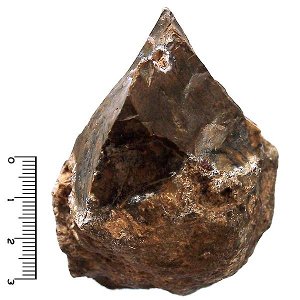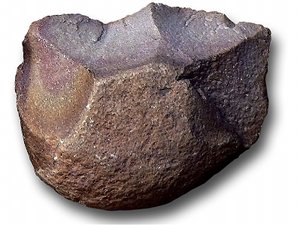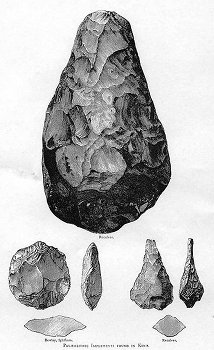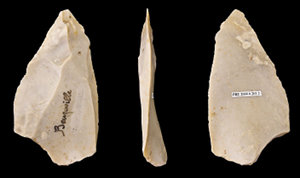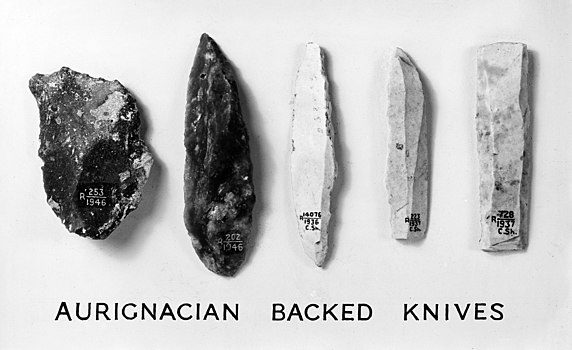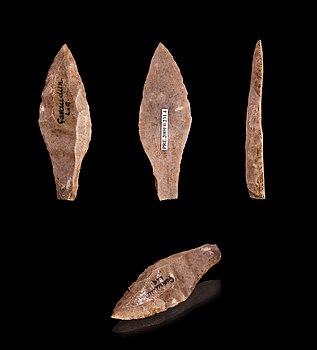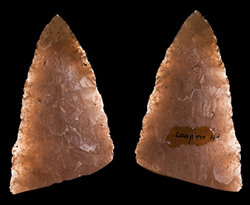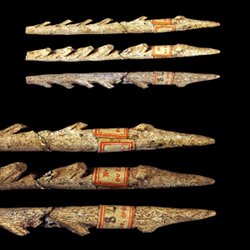Biological Anthropology/Unit 3: Human Evolution/MaterialCulture
Contents
IMPORTANT NOTE: THESE PAGES WILL NO LONGER BE UPDATED. THEY HAVE BEEN MOVED TO PRESSBOOKS AS PART OF A COLLEGE INITIATIVE TO COLLECT OER MATERIALS IN ONE PLACE FOR STUDENTS.
Stone Tools
The earliest evidence of material culture is in the form of stone tools. This does not mean that tools weren't used earlier. It's possible that proto- and early-hominins were using tools that were made of organic materials that did not preserve, e.g., sticks used to fish for termites. Recent finds from Dikika, Ethiopia in the Afar region, indicate that A. afarensis used stone tools to extract marrow from bones 3.4 million years ago. What this study does not show is whether A. afarensis was making tools or using a found rock. You can read more about this recent find and the Dikika Research project at http://research.calacademy.org/anthro/research/dikika. However, an announcement in May 2015 is rewriting what we know about stone tools.
Harmand et al. (2015) published that they had found 3.3 million-year-old (myo) stone tools at Lomekwi 3, West Turkana, Kenya, which they propose calling Lomekwian as the tools predate Oldowan tools (see below) by 700,000 years. What is particuarly interesting is that the oldest Homo fossils found in West Turkana are 2.34 mya. Kenyanthropus platyops (not covered in the overview of early hominins, but you can learn about it at Becoming Human) is the only hominin known from the area at that time, although Au. afarensis is known from 3.39 mya. Questions remain as to which hominin left behind the assemblage (an assemblage is a group of artifacts found together at a specific site) of 149 artifacts, including flake fragments, worked cobbles, and cores, and how it compares with Oldowan tools. As this is such a recent discovery, it is not covered in any more detail on this page.
Osteodontokeratic Culture
Paleoanthropologists have long been interested in the cultural aspects of hominins. Not all of the tool industries identified in the past stood the test of time. The osteodontokeratic tool culture was the earliest tool industry to be described, but was later discredited. In 1949, Raymond Dart, who discovered A. africanus, recorded numerous broken animal and hominin bones, horns and teeth at Makapansgat Cave, South Africa. The bones were broken and gnawed and many showed puncture marks. Dart interpreted this find as evidence that hominins used bone, teeth and horn (osteo-donto-keratic) as weapons, not only for hunting but against one another. From this interpretation sprang the idea that early hominins were violent killer-apes, an idea that has remained in the popular zeitgeist to this day.
Years later, C.K. Brain, working at Swartskrans, South Africa, found a similar artifact assemblage. Brain found that about 40% of the hominin fossil assemblage was comprised of young robust australopiths, many of which looked similar to the bones fossils that Dart had found at Makapansgat--they were broken, gnawed and had puncture marks. After a careful taphonomic study, Brain developed the Leopard Hypothesis. He found that the puncture marks were consistent with the width of leopard canines. He concluded that the robust australopiths were hunted. The reason that there were so many young australopiths is that they were more vulnerable, not having the same skills as adult australopiths. He also noted that many of the bones had cut marks over tooth marks, indicating that an animal had gnawed the bones and then a hominin, probably Homo hablis, which was also found at the site, scavenged the australopith bones. Brain's work effectively debunked Dart's osteodontokeratic proposal.
Oldowan Tool Industry
The oldest stone tool assemblage is the Oldowan tool industry (at least it is the oldest until the field comes to a consensus about Lomekwian tools). First identified at Olduvai Gorge, Tanzania by Louis and Mary Leakey, Oldowan tools are stone pebble tools manufactured using a hard percussion technique. This technique involves striking two stones together to knock off a flake or create an edge on a piece of stone. While this seems like a simple technique, to make one of these tools, the individual needs to be able to understand how the stone will break when struck. The presence of Oldowan tools is an indication of changing cognitive abilities.Originally, paleoanthropologists thought that the hammerstone was the primary tool used, but microwear analysis, a methodology whereby stone tools are examined under a microscope and the use wear patterns compared to use wear patterns established through experimental archaeology, indicates that the flake tools were the primary tool. Oldowan tools were used for cutting, chopping and scraping.
Louis Leakey believed that the Oldowan tools were evidence that Homo hablis, the fossil hominin found associated with the tools at Olduvai Gorge, hunted, especially since numerous animal fossils were found at the site. However, the mere presence of stone tools and animal fossils does not confirm hunting behavior. In the early 1980s, Rob Blumenschine conducted a year-long study on the Serengeti and in riparian (river banks) habitats. Blumenschine observed around 250 feedings by both predatory and scavenger carnivores such as lions, cheetahs, hyenas, and vultures. What he noticed that was when a predator ate, they would eat the meatiest parts of the body, leaving behind primarily limb bones. He suggested that if hominins were hunting that the artifact assemblage should contain those animal bones with the most meat. If hominins were scavenging then limb bones would dominate the fossil animal bone assemblage. Additionally, he noted that if hominins hunted then cut marks from tools would underlie animal tooth marks and vice versus if they were scavenging.
Armed with this information, the Olduvai Gorge material was reexamined. Several new points came to light: 1) the damage on the bones was most similar to that left by carnivore activity, 2) the percentage of limb bones in the artifact assemblage met the expectations of scavenging behavior, and 3) the cut marks overlay teeth marks. It was clear at this point that Homo hablis was not hunting but scavenging. While conducting his research, Blumenschine had used Oldowan tools to scavenge a carcass. He found that in about 10 minutes, it was possible to extract enough meat and bone to meet about 60% of the estimated daily caloric intake (approximately 1500 calories). Blumenschine demonstrated that it was an easy feat to scare off other scavengers and even some predators in order to gain access to the carcass. As a subsistence strategy, scavenging does have some advantages:
- it is less dangerous as the scavenger does not have to risk themselves for the kill
- it is quicker as the scavenger can simply follow the roar of the lion or look for vultures circling overhead
- there is less energy expenditure for the reasons listed above and the short amount of time it would take to butcher the remaining carcass using stone tools
The first definitive evidence of hunting is from Schöningen, Germany in the form of wooden spears dated to 400,000 years. The artifacts were identified as spears because they have similar morphology to modern javelins, e.g., the balance point is 1/3 the way from the spear point. The spears are about 7 feet long with sharpened points and were found with the remains of butchered horses.
Until recently, one of the long running debates has centered on who was the first tool user. With the recent announcement by the Dikika Research Project, the nature of that debate may change from who was the first user to who was the first maker. The previously oldest tools came from Gona, Ethiopia dated to 2.4 million years ago. As these tools were not found associated with any hominin fossils, paleoanthropologists debated who made the tools. The time frame puts several hominins in play: Au. garhi, P. robustus, H, rudolfensis, and H. habilis. Studies show that P. robustus had the hand morphology for making tools, but many do not think that the species had the cognitive abilities. Plus, no P. robustus fossils have been found with stone tools. The same goes for Au. garhi. All researchers agree that Homo was making and using tools. Again, the recently reported finds from Lomekwi 3 may end up demonstrating that an early australopith was the first tool maker.
Acheulean Tool Industry
One thing we see with tool technologies is that as time passes the tools become more and more sophisticated. About 1.9 million years ago, Homo erectus invented a new sophisticated technology for making stone tools, which started with the hard percussion technique, but then employed a soft hammer technique to get more refined and sharper edges. This new tool industry is called the Acheulean.
The Acheulean tool industry, first found at St. Acheul, France, is characterized by bifacial tools. This means that the stone is worked on both sides. This tool industry is a marked step in the cognitive abilities of hominins because the tool has to be conceptualized prior to manufacturing. Dozens of flakes have to be removed precisely in order to maintain the symmetry of the tool and keep the edges straight. The signature tool of the Acheulean tool industry is the tear-drop shaped handaxe. Often referred to as the Swiss Army knife of the Pleistocene, the handaxe was an all-purpose tool used for a multitude of activities including digging, sawing, and cutting.
Mousterian Tool Industry
Neanderthals took the next step in the evolution of stone tools by making tools for specialized tasks. Named after a cave site in Le Moustier, France, these flake tools developed out of a manufacturing technique called the Levallois. This technique first arose with the Acheulean and is characterized by preparing the core of raw material from which flakes can be struck and then worked. Sharper tools with a finer edge are produced using this technique. Neanderthals shaped these flakes into tools like scrapers, blades, and projectile points, specifically spear points. In fact, at Neanderthal caves sites in the Middle East, there are a higher percentage of spear points found than at neighboring Homo sapiens sites. Mousterian tools are a technological advance, taking a high degree of conceptualization and knowledge of the properties of the stone. On average, it takes about 200 blows to make one flake tool.Upper Paleolithic Tool Industries
The Upper Paleolithic of Europe begins 45,000 years ago and ushers in further advances in tool technology. Not only are there a wider variety of tools made, but new materials are used, including bone and antler. Several regional types of tool industries emerge in the Upper Paleolithic. The first is the Aurignacian, which is characterized by blade tools. A blade tool is a tool that is at least twice as long as it is wide. The benefit of blade tool technology is that blades can be easily knocked off a prepared core and then made into a wide range of tools, e.g., projectile points, drills, needles, scrapers, burins. By 31,000 years ago, the Aurignacian is widespread throughout Europe, allowing archaeologists to trace the movement of modern Homo sapiens.
The Aurignacian tool industry disappears from the archaeological by 29,000 years ago. It is replaced by the Gravettian tool industry, which is found at European sites until around 21,000 years ago. This tool industry is characterized by small blades and denticulate (serrated) knives. The Gravettian also has projectile points with blunting (steep backing) that can be hafted onto a shaft. The small size of some of the projectile points leads some archaeologists to surmise that the bow and arrow was invented during the Gravettian, although the first definitive evidence of arrows comes from Stellmoor, Germany (10,500 years ago). It does appear that the atlatl, or spearthrower, was invented during this time frame. This is an important advance as it allowed a hunter to throw farther and with more force, making hunting the megafauna of the period a little safer.
The Gravettian is followed by the Solutrean and the Magdelenian tool industries. the Solutrean tool industry is characterized by bifacial, leaf-shaped projectile points. As far as stone tools go, the Solutrean points are some of the best made points of the Upper Paleolithic. The technology flourished from around 21,000 to 16,000 years ago, but then disappears for thousands of years until a similar manufacturing process appears in North America during the Clovis period. to explain this, some archaeologists propose that there was a migration of peoples from the Iberian Peninsula to North America in the late Pleistocene who carried the technology with them; however, other there is little other evidence to support this contention. It is probable that the manufacturing techniques was rediscovered by North America's early inhabitants.One of the reasons that Solutrean points were finely made was because the stone was heat treated before it was worked. Heat treatment means that the stone was placed in a fire for a period of time, making it possible to make pressure flaking more precise. Heat treating was also a hallmark of the Magdelenian tool industry, 16,000-11,000 years ago. Bone and antler tools flourish during the Magdelenian. Harpoons appear in the archaeological record, with true barbed harpoons showing up around 13,000 years ago.
Go To Previous Page
Go To Other Cultural Traits
References
Harmand S, Lewis JE, Feibel CS, Lepre CJ, Prat S, Lenoble A, Boës X, Quinn RL, Brenet M, Arroyo A, Taylor N, Clément S, Daver G, Brugal JP, Leakey L, Mortlock RA, Wright JD, Lokorodi S, Kirwa C, Kent DV, Roche H. 2015. 3.3-million-year-old tools from Lomekwi 3, West Turkana, Kenya. Nature 521 (May 21): 310-315. Available from: http://www.nature.com.offcampus.lib.washington.edu/nature/journal/v521/n7552/full/nature14464.html. doi:10.1038/nature14464.
Price, T. Douglas and Gary M. Feinman. 2010. Images of the Past, 6th edition. New York: McGraw Hill.
Scarre, Chris. 2005. The Human Past. London: Thames & Hudson Ltd.
Straus, Lawrence Guy. 2005. The Upper Paleolithic of Cantabrian Spain. Evolutionary Anthropology 14: 145-158.
